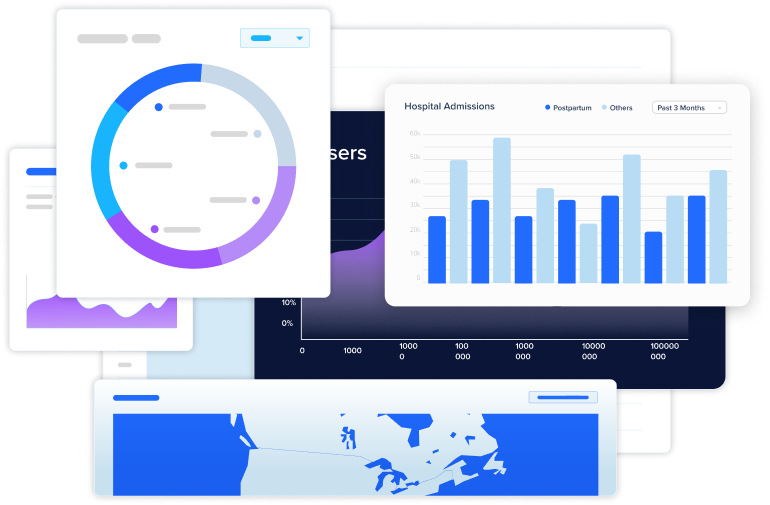
Government Benchmarking or Bust: The Power of Knowing Where You Stand
How benchmarking helps craft data-driven government strategies that help you prove impact, drive meaningful change, and deliver measurable ROI.
You can’t fix what you can’t measure.
In government, this simple truth carries enormous weight. Leaders are tasked with addressing some of the most complex and urgent challenges of our time—housing instability, food insecurity, workforce gaps, and declining health outcomes. Yet many are doing so with incomplete, outdated, or one-off data snapshots.
That’s where benchmarking comes in.
Why Government Benchmarking Matters
 Benchmarking isn’t just about comparing numbers—it’s about creating a clear, evolving picture of community well-being. When government leaders have access to data that shows how they’re performing relative to themselves over time and to peer regions, they gain an edge in making decisions that actually move the needle.
Benchmarking isn’t just about comparing numbers—it’s about creating a clear, evolving picture of community well-being. When government leaders have access to data that shows how they’re performing relative to themselves over time and to peer regions, they gain an edge in making decisions that actually move the needle.
Whether you’re applying for a grant, justifying a new initiative, or refining a multi-agency response to a public health crisis, the ability to say “here’s where we were, here’s where we are, and here’s where we need to go” changes the conversation.
It turns vague goals into measurable progress. It turns reactive governance into a proactive strategy.
The Challenge: Data That Lags
 Traditional tools—such as periodic community needs assessments—often fall short. They take months to complete, cost tens or even hundreds of thousands of dollars, and offer a single moment in time. By the time the report is in hand, the data is already starting to go stale.
Traditional tools—such as periodic community needs assessments—often fall short. They take months to complete, cost tens or even hundreds of thousands of dollars, and offer a single moment in time. By the time the report is in hand, the data is already starting to go stale.
Meanwhile, community needs are evolving fast. A workforce crisis might unfold in months. A new affordable housing initiative might shift neighborhood dynamics within a year. Lagging data makes it harder to respond to these changes in real time—and nearly impossible to prove what’s working.
The Solution: Real-Time Benchmarking with Unite Us
 Unite Us’ Self Sufficiency Score gives government leaders a dynamic, hyperlocal look at constituents’ social and economic needs. It equips governments with built-in benchmarking tools to:
Unite Us’ Self Sufficiency Score gives government leaders a dynamic, hyperlocal look at constituents’ social and economic needs. It equips governments with built-in benchmarking tools to:
- Track change over time: See how Self Sufficiency Scores shift as people secure jobs, gain regular access to preventive care, maintain stable housing, and build long-term financial stability.
- Compare across geographies: Understand how your community–at the city, state, or zip code level–stacks up against neighboring regions with similar profiles.
- Target interventions more precisely: Drill down to the state, county, or neighborhood level to direct resources where they’re needed most.
- Tell a stronger story: Use data to demonstrate need, impact, and readiness in grant proposals, budget hearings, and community meetings.
Government Benchmarking in Action
 Imagine a state or county preparing to apply for a competitive workforce development grant. In the past, they might have relied on a static snapshot of unemployment rates, and/or a regional-level figure on general access to public transportation. But with Unite Us, they can go further—much further.
Imagine a state or county preparing to apply for a competitive workforce development grant. In the past, they might have relied on a static snapshot of unemployment rates, and/or a regional-level figure on general access to public transportation. But with Unite Us, they can go further—much further.
They can identify which regions have the highest predicted risk of unemployment, where residents face transportation barriers to job training programs, and where support services are most urgently needed. They can even drill down to the individual level to pinpoint their residents’ specific needs, ensuring support reaches the people who need it most. More importantly, they can track how those conditions change over time.
Instead of simply describing the challenge, leaders can now tell a story of measurable progress: where they started, what actions they’ve taken, and where gaps remain. It’s not just a grant application—it’s a living, place-based narrative of impact. And that kind of story doesn’t just meet grant requirements—it strengthens the case for sustained investment.
A Smarter Standard for Smarter Government
 In today’s world, government leaders need more than a gut instinct or a once-a-decade report. They need dynamic, continuous insight—and the tools to act on it.
In today’s world, government leaders need more than a gut instinct or a once-a-decade report. They need dynamic, continuous insight—and the tools to act on it.
Benchmarking with Unite Us’ data solutions for Self-Sufficiency helps state and local governments move from guesswork to precision, from reactive to strategic, and from data-poor to insight-rich.
Because if you don’t know where you stand, how can you ever move forward?



